Willeson Metals Reports on Field Work at the Beaucage Gold Project Including 10.3 g/t Gold over 4.30 metres and 4.3 g/t Gold over 5.25 metres from the Chip and Channel Sampling Program
Toronto, Ontario, January 30, 2023 – Willeson Metals Corp. (the “Company” or “Willeson Metals”) is pleased to announce positive rock assay results from its 2022 geological mapping and sampling program completed at the Beaucage Gold Project ("Beaucage"), located approximately 55 km south-southeast of Lynn Lake, Manitoba. The program was completed in September 2022 and focused on three showings: the Star Lake Gold Showing, the Beatty Gold Showing, and the Ham Lake Gold Showing. All three areas returned positive results as discussed below.
Highlights:
- A total of 142 rock samples were collected including 22 grab samples, 70 continuous chip samples, and 50 saw-cut channel samples from outcrops, historical pits and trenches.
- Star Lake Gold Showing:
- 10 samples, representing 17% of the Star Lake Gold assay results, returned >1.0 g/t gold.
- Results include 2.1 g/t gold over 12.15 m, including 4.3 g/t gold over 5.25 m, in composite continuous chip and channel samples from a historical trench.
- Mineralization extends approximately 100 m along strike at the historical trenches, supporting the interpreted northwest-southeast trending mineralized corridor, which is open in both directions. This corridor includes the 2021 composite chip sample that graded 83.1 g/t over 3.3 m, in a historical trench. Visible gold was observed at this sample location in 2022.
- A mineralized grab sample, grading 0.7 g/t gold, was collected 450 m northwest of the trenches, suggesting that the northwest trending corridor of quartz vein mineralization in diorite may extend for at least 550 m in strike length.
- Beatty Gold Showing:
- 15 samples, representing 25% of the Beatty Gold assay results, returned >1.0 g/t gold.
- Continuous chip and channel sampling in the Beatty North area included composite grades of:
- 11.3 g/t gold over 2.00 m, including 35.2 g/t gold over 0.60 m
- 8.5 g/t gold over 1.20 m including 19.8 g/t gold over 0.50 m, with visible gold
- Continuous chip and channel sampling at Beatty South included composite grades of:
- 10.3 g/t gold over 4.30 m, including 40.4 g/t gold over 0.90 m
- 1.6 g/t gold over 11.00 m, including 2.4 g/t gold over 7.00 m and 7.2 g/t gold over 1.00m
- Mineralization extends along strike from Beatty North and South, indicating a northwest-southeast trending mineralized corridor up to 1.5 km in length.
- Ham Lake Gold Showing:
- 7 samples, representing 33% of the Ham Lake Arkose assay results, returned >0.5 g/t gold, of which 2 were >1.0 g/t gold.
- Continuous chip and channel sampling of historical trenches included composite grades of:
- 1.0 g/t gold over 5.00 m, including 3.8 g/t gold over 1.00 m
- 0.6 g/t gold over 3.00 m
- 1.1 g/t gold over 6.50 m including 4.8 g/t gold over 1.00 m
- Willeson’s 2022 field program at Beaucage was supported by the first $100,000 installment of a $300,000 grant awarded by MMDF and administered by the Manitoba Chambers of Commerce.
- Proposed 2023 fieldwork, contingent on financing, includes regional prospecting, detailed mapping, rock sampling, and a Phase 1 summer/fall diamond drill program of 2,000 m to 3,000 m at the Star Lake and Beatty Gold Showings
Stephanie Hart, President and CEO of Willeson, commented, “These 2022 sample results confirmed the interpreted continuity of mineralized zones hosting high-grade gold mineralization in quartz veins at several Beaucage targets. We are particularly excited to follow up the historically undrilled Star Lake and Beatty Gold targets with a proposed 2023 diamond drill program and additional field work once financing is secured.”
Beaucage Gold Project Overview
The Beaucage Gold Project is located approximately 55 km by air south-southeast of the town of Lynn Lake, Manitoba. Beaucage consists of 23 contiguous mining claims encompassing 5,888 hectares. The claims are 100% owned by Willeson.
Beaucage lies along the contact of the Lynn Lake Volcanic Belt and Kisseynew Gneissic Basin of the Churchill Province and boasts numerous significant historical gold assay values associated with multiple styles of gold mineralization, including iron formation (IF)-hosted, structurally controlled stockwork and veins in Sickle clastic sediments; and quartz-veined shear zones in the Black Trout Diorite. The project area has had little recent exploration with almost no follow-up work on most of the high grade gold showings.
2022 Field Work, Rock Sampling Results
Ian Trinder, Vice President, Exploration of Willeson commented “Willeson’s encouraging 2022 continuous chip and channel sample results have confirmed historical, typically grab sample, gold assay values associated with structurally controlled gold mineralization in both the Black Trout Diorite and Sickle clastic sediments, and new sampling has confirmed the continuity of favourable structures and geological environments along strike of historically sampled areas at the Star Lake, Beatty and Ham Lake showings. With drill permits in place, we look forward to starting the proposed drill program at Star Lake and Beatty in 2023”.
The Company mobilized a 7-person crew to conduct a Lynn Lake based helicopter-supported exploration program, focused on exploration of historical gold showings at Beaucage (Figure 1). Field work was completed in September 2022.
A total of 142 rock samples were collected at Beaucage with gold values assaying <0.005 up to 40.4 g/t gold. Thirty-seven samples returned >0.5 g/t gold of which twenty-seven samples returned >1.0 g/t gold (Table 1). Samples included 22 grab samples, 70 continuous chip samples, and 50 saw-cut channel samples collected from outcrops and historical pits and trenches. Sample collection, preparation and analytical methology described under separate heading at the end of this news release.
The Star Lake Gold Showing is characterized by diorite-hosted quartz veins. Preliminary observations suggest a strong gold association with sulphides (dominantly pyrite) in quartz veining and diorite wall rock exposed in outcrops and historical pits and trenches within an area at least 250 m east-west by 100 m north-south. The showing lies within a historical chargeability high approximately 700 m in length and up to 200 m wide and a coincident magnetic low, suggestive of a potential extensive alteration zone of pyritization and and magnetite destruction associated with gold mineralization. Exposed veins up to approximately 1 m thick trend northwest and dip moderately to the north. In 2021, a total of 37 samples were collected and returned gold values up to 301 g/t gold; 13 samples returned >1.0 g/t gold (see April 8, 2022 News Release). Continuous chip and channel sampling of a historical blast trench (Trench 2) in 2021 returned a composite grade of 1.5 g/t gold over 10.5 m and a select interval on the opposite wall of the same trench returned a composite grade of 83.1 g/t gold over 3.3 m including 301 g/t gold over 0.9 m (Figure 2). Visual re-examination of this high-grade sample site in 2022 confirmed the presence of visible gold (Figure 3).
A total of 60 samples were collected in the Star Lake area in 2022 and returned gold values up to 15.6 g/t gold; 13 samples returned >0.5 g/t gold, of which 10 were >1.0 g/t gold (Table 1). Follow-up 2022 continuous chip and channel sampling of three additional historical trenches and outcrops in the immediate area of the historical Trench 2 covered a strike of approximately 65 m and apparent width of approximately 35 m (Table 1 and Figure 2).
Mineralization extends approximately 100 m along strike at the historical Star Lake trenches, supporting the interpreted northwest-southeast trending mineralized corridor, which is open in both directions. Approximately 450 m northwest of the Star Lake trenches, a grab sample from an isolated outcrop of diorite with a shear-hosted 3 to 5 cm thick quartz vein returned a grade of 0.7 g/t gold (Table 1). The outcrop lies within a historical linear chargeability high extending from the Star Lake Showing, suggesting that the northwest trending corridor of quartz vein mineralization in diorite may extend for at least 550 m in strike length.
The Beatty Gold showing area, located approximately 1.3 km east of the Star Lake showing, is also characterized by diorite-hosted quartz veins and a gold association with sulphides (dominantly pyrite) in quartz veining and diorite wall rock at two locations approximately 450 m apart. Exposed veins suggest two potential trends: north and west-northwest. A historical chargeability high is associated with the Beatty North area and extends to the northwest and southeast. The historical IP survey did not cover the Beatty South area. In 2021, a total of 30 samples were collected and returned gold values up to 36.9 g/t gold with seven of the samples returning >1.0 g/t gold (see April 8, 2022 News Release).
A total of 59 follow-up samples were collected in the Beatty area in 2022 and returned gold values up to 40.4 g/t gold; 17 samples returned >0.5 g/t gold, of which 15 were >1.0 g/t gold (Table 1). Sampling was primarily focused at historically trenched Beatty North (Figure 4) and Beatty South (Figure 5 - approximately 450 m southeast of Beatty North). A 0.50 m channel sample at Beatty North contained visible gold and returned 19.8 g/t gold (Table 1).
Sampling up to 100 m southeast from Beatty North intersected 0.9 g/t gold over 1.10 m, 4.5 g/t gold over 1.30 m, and 13.0 g/t gold over 0.80 m, confirming the potential for a continuous mineralized zone extending between Beatty North and South (Table 1, Figure 4). An outcrop of extensive quarz veining in diorite approximately 50 m south of Beatty South Trench 5 was not sampled due to time constraints but indicates potential to extend mineralization further to the southwest (Figure 5). Additionally, limited prospecting of a historical chargeability high approximately 1 km northwest of Beatty North returned 3.5 g/t gold from a grab sample of quartz vein material indicating a significant northwest-southeast trending mineralized corridor up to 1.5 km in length in the Beatty area.
The Ham Lake showing area, located approximately 2 km north-northwest of the Star Lake showing, comprises multiple locations characterized by arkose-hosted quartz veins in proximity to narrow diorite dykes and sills. In 2021, Willeson sampled primarily at two locations approximately 800 m apart. A total of 11 samples returned gold values up to 36.9 g/t gold with two samples returning >1.0 g/t gold (see April 8, 2022 News Release).
In 2022, a total of 21 samples were collected in the southern Ham Lake area, approximately 1400 m and 600 m south-southeast of the areas sampled in 2021 and returned gold values up to 4.8 g/t gold. Seven samples returned >0.5 g/t gold, of which two were >1.0 g/t gold (Table 1).
2023 Outlook
Willeson’s 2022 sampling confirmed and validated historical gold assay results and spatially expanded the gold mineralization reported at several historical mineral showings at Beacauge. Sample results and general vein trends observed in 2021 and 2022 together with compiled historical results will inform a proposed preliminary Phase 1 Summer/Fall 2023 diamond drill program totalling 2,000 m to 3,000 m at the Star Lake and Beatty occurrences. Additional surface sampling at Beatty and its potential extensions is planned in 2023 together with the preliminary diamond drill testing. Detailed mapping and sampling at Ham Lake is also planned to advance the geological understanding of the controls on gold mineralization prior to a future diamond drilling program. Reconnaissance prospecting and geochemistry will continue as appropriate with respect to funding and personnel availability.
Willeson regularly engages with local First Nations and has completed an Exploration Agreement with Marcel Colomb First Nation. Work permits are currently in place for proposed exploration at Beaucage and will be renewed as required.
Manitoba Mineral Development Fund (MMDF)
Willeson’s 2022 field program at Beaucage was supported by the first $100,000 installment of a $300,000 grant awarded by MMDF and administered by the Manitoba Chambers of Commerce. The remaining amounts are to be received in May and September 2023 for the planned Star Lake/Beatty drill program and are contingent on financing and renewal of permits.
About Willeson Metals Corp.
Willeson is a Canadian-based, privately-owned mineral exploration company focused on the acquisition, exploration, and development of high-quality gold projects in the province of Manitoba, with a particular emphasis on Proterozoic terrains which, in Canada, have long been under-explored for gold. The company’s portfolio of four, 100%-owned, gold projects are all located within the Proterozoic Lynn Lake greenstone belt of northern Manitoba.
Willeson’s vision is to explore for and discover Tier 1 gold deposits in Proterozoic terrains and to do so in a responsible, safe and sustainable manner in order to create long-term value for all stakeholders, including the communities near its properties.
For further information contact:
Stephanie Hart
President & CEO
Willeson Metals
stephanie.hart@willesonmetals.com
289 937 6657
Table 1: 2022 Rock samples and composite sample intervals returning greater than 0.5 g/t gold
| Occurrence | Target_Detail | Au (g/t) | Sample Width (m) | Sample_Type | UTM E NAD 83 |
UTM N NAD83 |
||
| Star Lake | Trench 1 | 0.5 | 11.80 | Continuous Chip | Composite | 401401 | 6261673 | |
| incl | 1.0 | 2.00 | Continuous Chip | Composite | 401403 | 6261675 | ||
| and | 1.1 | 1.00 | Continuous Chip | Single | 401401 | 6261671 | ||
| and | 1.1 | 2.00 | Continuous Chip | Composite | 401399 | 6261669 | ||
| Star Lake | Trench 1 Ext | 0.6 | 5.20 | Channel | Composite | 401394 | 6261656 | |
| incl | 1.5 | 1.60 | Channel | Composite | 401395 | 6261657 | ||
| Star Lake | Trench 3 | 0.5 | 8.50 | Continuous Chip/Channel | Composite | 401368 | 6261678 | |
| incl | 1.7 | 0.50 | Continuous Chip | Single | 401369 | 6261679 | ||
| and | 1.1 | 1.75 | Continuous Chip | Composite | 401367 | 6261675 | ||
| Star Lake | Trench 4 | 2.1 | 12.15 | Continuous Chip/Channel | Composite | 401400 | 6261647 | |
| incl | 2.0 | 1.50 | Channel | Composite | 401398 | 6261643 | ||
| and | 4.3 | 5.25 | Continuous Chip | Composite | 401401 | 6261651 | ||
| incl | 15.6 | 1.00 | Continuous Chip | Single | 401402 | 6261649 | ||
| incl | 14.5 | 0.40 | Continuous Chip | Single | 401403 | 6261653 | ||
| 4.2 | 0.90 | Channel | Single | 401398 | 6261644 | |||
| Star Lake | Outcrop | 0.4 | NA | Grab | Single | 401414 | 6261636 | |
| Star Lake | b/w Rex and Ham Lakes | 0.7 | NA | Grab | Single | 401064 | 6261992 | |
| Beatty | North Trench Area | 11.3 | 2.00 | Continuous Chip | Composite | 402668 | 6261960 | |
| incl | 35.2 | 0.60 | Continuous Chip | Single | 402668 | 6261960 | ||
| 8.5 | 1.20 | Channel | Composite | 402673 | 6261959 | |||
| incl | 19.8 | 0.50 | Channel | Single | 402672 | 6261959 | ||
| 0.9 | 1.10 | Continuous Chip | Single | 402773 | 6261888 | |||
| 4.5 | 1.30 | Continuous Chip | Single | 402773 | 6261888 | |||
| 13.0 | 0.80 | Continuous Chip | Single | 402765 | 6261857 | |||
| Beatty | North Chargeability Area | 3.5 | NA | Grab | Single | 401909 | 6262600 | |
| Beatty | South Area Trench 3 | 10.3 | 4.30 | Continuous Chip | Composite | 403016 | 6261653 | |
| incl | 40.4 | 0.90 | Continuous Chip | Single | 403015 | 6261653 | ||
| Beatty | South Area Trench 4 | 3.1 | 1.40 | Continuous Chip | Single | 403029 | 6261645 | |
| Beatty | South Area Trench 5 | 1.6 | 11.00 | Channel | Composite | 403018 | 6261627 | |
| incl | 2.4 | 7.00 | Channel | Composite | 403017 | 6261625 | ||
| incl | 7.2 | 1.00 | Channel | Single | 403017 | 6261625 | ||
| Ham Lake Arkose | Southern Area Trench 1 | 1.0 | 5.00 | Continuous Chip | Composite | 400791 | 6262520 | |
| incl | 3.8 | 1.00 | Continuous Chip | Single | 400791 | 6262520 | ||
| Ham Lake Arkose | Southern Area Trench 2 | 0.6 | 3.00 | Continuous Chip | Composite | 400781 | 6262512 | |
| Ham Lake Arkose | Southern Area Trench 3 | 1.1 | 6.50 | Continuous Chip | Composite | 400531 | 6262556 | |
| incl | 4.8 | 1.00 | Continuous Chip | Single | 400531 | 6262555 | ||
* Note: Sample widths are reported as apparent widths; true thicknesses are undetermined.
Figure 1: Location of the Beaucage Project gold showings
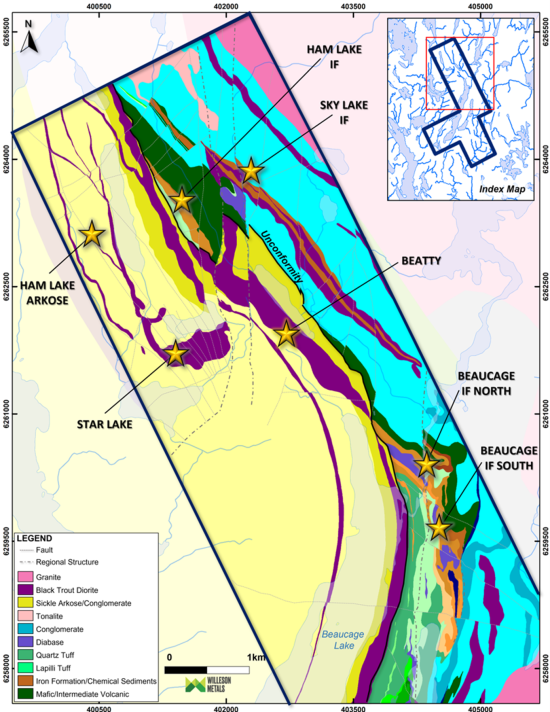
Figure 2: 2021-2022 Rock Samples at Star Lake Showing
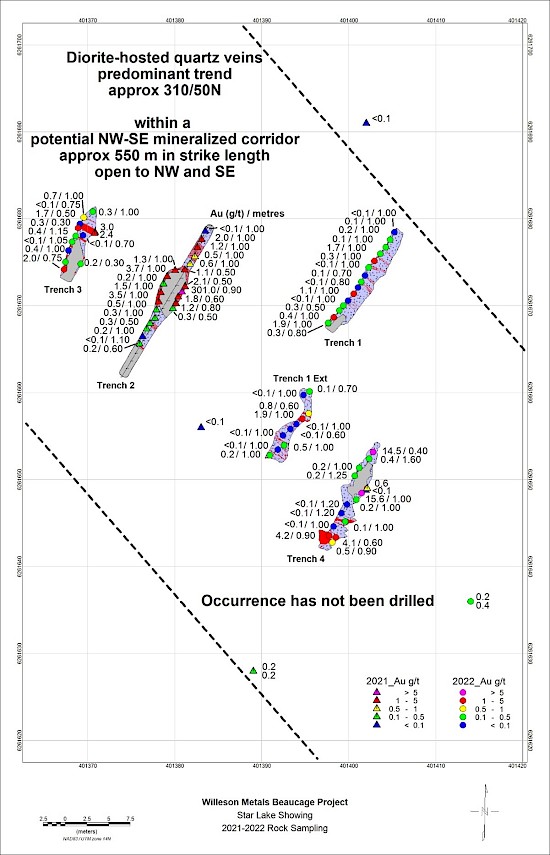
Figure 3: Visible gold observed in 2022 at 2021 sample site X024725 which returned 301 g/t Au over 0.9m
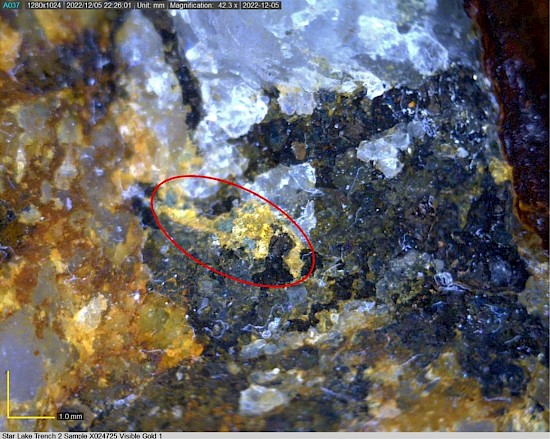
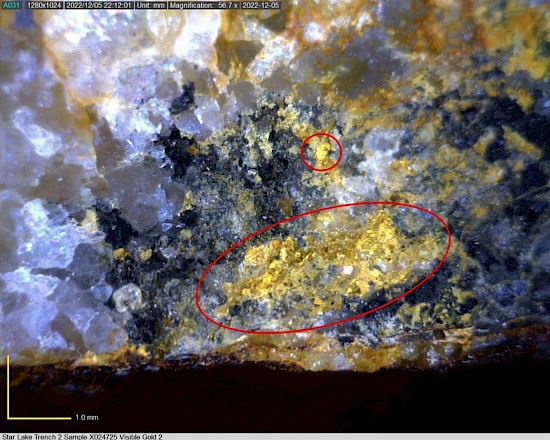
Figure 4: 2021-2022 Rock Samples at Beatty North Showing
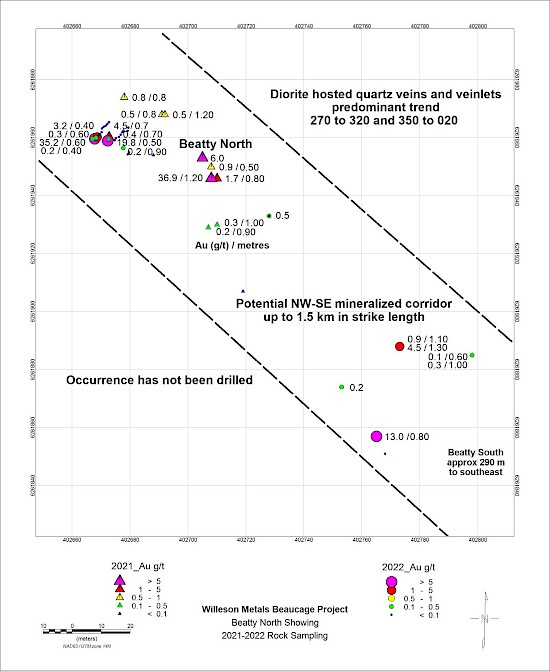
Figure 5: 2021-2022 Rock Samples at Beatty South Showing
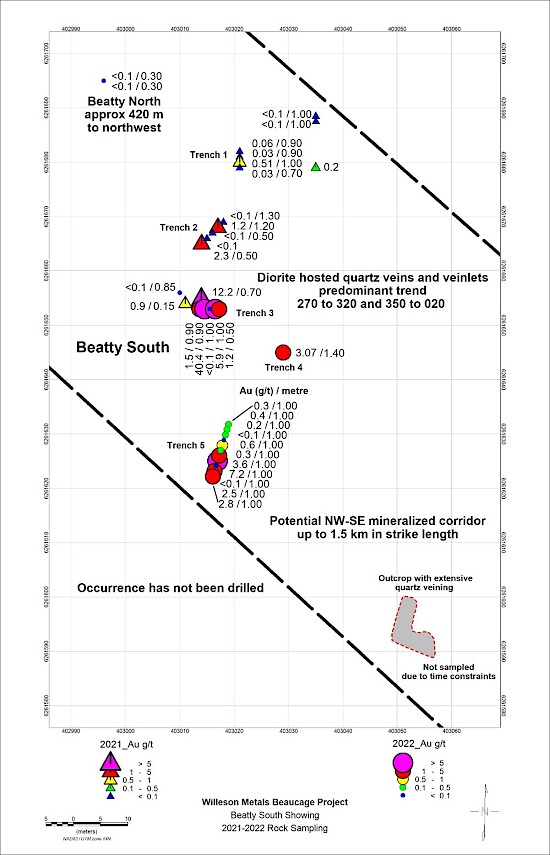
Qualified Person
Ian Trinder, P.Geo. and Vice President, Exploration, for the Company and a qualified person as defined by National Instrument 43-101, has reviewed, and approved the technical content of this news release.
Sample Collection, Security, Preparation, Analytical and QAQC Methodology
Bedrock samples comprised grab, continuous chip and saw-cut channel samples. A grab sample, collected from a rock surface using a hammer, typically consists of selective pieces of the strongest mineralized material or material of particular interest, Consequently, a grab sample is generally not representative of the overall mineralization or rock type and is typically collected to get an idea what the best possible values might be.
A continuous chip sample consists of a number of small contiguous rock chips broken from a rock surface using a hammer and chisel along an approximate straight line generally 1 m or less in length across the zone of interest. The chips are composited into one sample representing the width of the interval sampled. Mineralized widths over 1 m generally require several continuous chip samples. A continuous chip sample is a more representative sample for a specified sample interval than a grab sample.
A saw-cut channel sample is collected from a continuous channel cut across the width of a mineralized zone exposed on a generally smooth, unbroken outcrop or trench surface. Mineralized widths over 1 metre generally require several continuous channel samples. A gas-powered portable rock saw with a rotating diamond tipped blade is used to cut a straight channel by making two parallel cuts approximately 6 cm apart, approximately 6 cm deep and typically 1 m in length. A hammer and chisel is then used to break the rock free from the channel. A channel sample is a more representative sample for a specified sample interval than a continuous chip sample.
Samples were placed into individual poly sample bags at the sample site, a commercial unique numbered sample tag was inserted into each bag, the bags were labeled with the unique tag numbers using permanent marker and the bag was then sealed with a ladder lock zip tie.
Samples were transported daily from the Beaucage Gold Project to Lynn Lake, Manitoba where they were securely stored until the end of the program. Willeson personnel then transported samples as a single batch to the ALS Canada Ltd. (ALS) laboratory in Winnipeg, Manitoba for preparation. ALS is ISO/IEC 17025:2017 and ISO 9001:2015 certified and independent of Willeson.
Sample preparation consisted of drying, as required, and crushing to 70% less than 2 mm or better using a jaw and/or roller crusher. The crushed sample was split using a riffle splitter and an approximately 1000 g split was pulverized to 85% less than 75 microns or better using a ring and puck grinding mill. The pulverized splits of the samples were then transported by ALS from the Winnipeg preparation facility to their facility in North Vancouver, British Columbia for analyses.
All samples were analyzed for gold by fire assay, (ALS code Au-AA23), using a 30 g pulp sample aliquot with an atomic absorption spectroscopy finish. All samples with results above the 10-g/t upper detection limit of Au-AA23, were re-analysed by fire assay with a gravimetric finish (ALS code Au-GRA21). Samples were also analyzed for 48 elements (Ag, Al, As, Ba, Be, Bi, Ca, Cd, Ce, Co, Cr, Cs, Cu, Fe, Ga, Ge, Hf, In, K, La, Li, Mg, Mn, Mo, Na, Nb, Ni, P, Pb, Rb, Re, S, Sb, Sc, Se, Sn, Sr, Ta, Te, Th, Ti, Tl, U, V, W, Y, Zn, Zr) using a four-acid near total digestion of a 0.4 g pulp sample aliquot and inductively coupled plasma mass spectrometer (ICP-MS) detection method (ALS code ME-ICP61a).
Sample QAQC included the insertion of seven coarse blank samples (commercial ornamental granite garden stone) and seven unmarked certified standard reference materials. All standards passed within one to two standard deviations of the certified value and all blanks reported acceptable values.
Cautionary Statements Regarding Forward Looking Information
This press release includes certain "forward-looking information" and "forward-looking statements" (collectively "forward-looking statements") within the meaning of applicable securities legislation. All statements, other than statements of historical fact, included herein, without limitation, statements relating the future operating or financial performance of Willeson, are forward-looking statements.
Forward-looking statements are frequently, but not always, identified by words such as "expects", "anticipates", "believes", "intends", "estimates", "potential", "plans", "possible", and similar expressions, or statements that events, conditions, or results "will", "may", "could", or "should" occur or be achieved. Forward-looking statements in this announcement relate to, among other things: the Company’s objectives, goals or future plans, statements, exploration and development plans, timing of the commencement of operations and estimates of market conditions. Actual future results may differ materially. There can be no assurance that such statements will prove to be accurate, and actual results and future events could differ materially from those anticipated in such statements. Forward-looking statements reflect the beliefs, opinions and projections on the date the statements are made and are based upon a number of assumptions and estimates that, while considered reasonable by the respective parties, are inherently subject to significant business, economic, competitive, political and social uncertainties and contingencies. Many factors, both known and unknown, could cause actual results, performance or achievements to be materially different from the results, performance or achievements that are or may be expressed or implied by such forward-looking statements and the parties have made assumptions and estimates based on or related to many of these factors. Readers should not place undue reliance on the forward-looking statements and information contained in this news release concerning these times. Except as required by law, Willeson does not assume any obligation to update the forward-looking statements of beliefs, opinions, projections, or other factors, should they change, except as required by law.